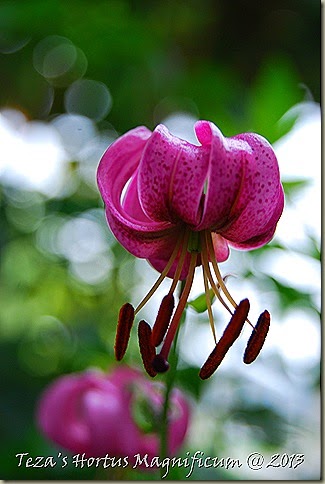If I said I’d been waiting my entire life for this day, you might think I am some sort of plant geek freak….. and rightfully so! I have watched ever so patiently for the past three years, coaxing this delightful woodland gem to continue sending forth its beautiful palmate foliage, stem after stem, ever diligent to make sure that nothing or nobody [an impatient gardener who thrusts his destructive trowel into the ground, possibly severing its delicate root system – who me?!?] bring forth its early demise.
The plant in question – Glaucidium palmatum, a rare and choice Japanese woodlander whose elegant, umbrella-like palmate foliage acts as a foil for the papery lavender, poppy like blooms! Perhaps the esteemed plantsman Daniel Hinkley describes its ethereal beauty best:
‘… while exploring the slopes of the northern shores of Lake Towada in northern Japan in 1997, I came upon curious dried, two lobed seed capsules that looked vaguely familiar. As the frosts of Autumn had already settled hard upon the landscape, the foliage was completely absent, and I was left to ponder its identity, with but one clue.
A moment I will not soon forget is when it dawned on me that I was walking amidst a rather sizable colony of Glaucidium palmatum. Never being one who could be considered remotely restrained, and certainly outside the protocol of Japanese understatement, I whooped with joy! [Authorial note: See, I am not the only one people!] Not only a friend, but one of the loveliest of the woodland perennials! The genus has made the taxonomic rounds, bouncing between the families Paeonceae, Gluacidiaceae and Ranunculaceae!
In mid-Spring, robust mounds of bright green, lobed, palmate leaves are formed along stout 0.6m stems. The leaves grow to 15cm across, becoming progressively smaller and less lobed as they ascend the stem. Directly above the last leaf, atop the remaining inch of stem, slightly nodding, silken lavender flowers are produced in May and June. When backlit by morning or late evening sun, and glistening with a wash of dew or recent rain, a scene is created that even the most jaded must stop to behold…’
I could not have worded it better myself! It has a robust hardiness between Zone 4-8, perhaps colder if mulched in winter. It does not tolerate arid or humid climates, but mine does quite well with the shaded protection of the Shaded Walk! In cultivation, it grows naturally in Japan in cool, moist, humus rich soils on a steep slope beneath a high overstory of Cercidiphyllum japonicum. It is important to heed the edaphic requirements and provide shelter from hot, dissecting winds.
Seed is readily produced in cultivation where more than one clone is grown together. It should be sewn as fresh as possible and will take two years to germinate. Plants can be divided in late winter and will offer a number of dormant buds along a woody rootstock; use a sharp knife to remove these along with a substantial part of the root.
 As a collector of the rare and unusual, I live for moments just such as this! Has your garden rewarded you with any startling surprises or discoveries so far this year?
As a collector of the rare and unusual, I live for moments just such as this! Has your garden rewarded you with any startling surprises or discoveries so far this year?


































3 comments:
I heard THAT squeal ! haha
I had to do a search on this beauty to see a full flower and WOW ! it is beautiful !! You are one proud Papa seeing this little gem wake up and unfold to shine in the shaded walk.
Congratulations and many more to come!
Joy : )
Nice of you to share such plant excitement that all plant lovers can understand and feel. I just realized that one of the 'substitute plants' (in my alpine plant order) that I picked is this beauty. Now I couldn't wait to see its bloom like yours. (Unfortunately, I will have to replant it in humus soil rather than the sandy soil it is in now.)
"The mark of a true plantsman is the strength to call a dud a dud."
Christopher Lloyd
Post a Comment